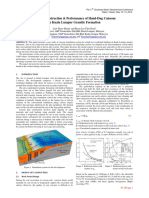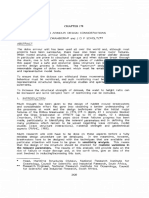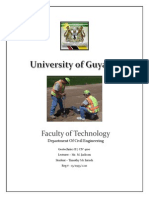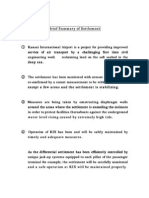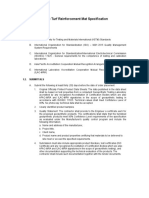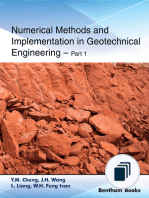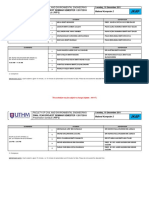Compaction Grout 1
Compaction Grout 1
Uploaded by
Kin HamzahCopyright:
Available Formats
Compaction Grout 1
Compaction Grout 1
Uploaded by
Kin HamzahOriginal Description:
Copyright
Available Formats
Share this document
Did you find this document useful?
Is this content inappropriate?
Copyright:
Available Formats
Compaction Grout 1
Compaction Grout 1
Uploaded by
Kin HamzahCopyright:
Available Formats
1.
3 COMPACTION GROUTING INTRODUCTION Compaction grouting technology has grown steadily over the last 30 years and is a well-esta lished and accepted practice Initially developed !or structural settlement control and re-Ieveling" the techni#ue has since een used to solve a num er o! other geotechnical pro lems$ During underground construction" particularly so!t-ground tunneling !or su way systems" compaction grouting has een used to control sur!ace settlements y pregrouting to densi!y and stress the soils to the point o! heave$ Thus" the in%ection o! grout &through preplaced grout pipes' %ust a!ter the tunnel oring machine passes is much more e!!ective in reesta lishing arching over the e(cavation and controlling sur!ace settler$lents &)a*er et al +,-3'$ The sta ili.ation o! *arst !ormations y compaction grouting to remediate e(isting or potential sin*hole pro lems has also ecome widely accepted$ In recent years" compaction grouting to depths on the order o! +/0 m &000 !t' has een accomplished in *arstic areas &1nonymous +,,2'$ Compaction grouting is also now widely accepted as a site improvement techni#ue" oth !or the mitigation o! li#ue!action potential and !or soil densi!ication to increase earing capacity and reduce settlements &Chastanet and )la*ita +,,/'$ 1mong the more recent innovative uses o! compaction grouting is the !ormation o! a continuous !oundation element y constructing a pressure-in%ected !ooting at depth to support a column o! compaction grout up to design elevation The compaction grout 3pile3 thus !ormed generally incorporates a continuous rein!orcing mem er$ 1s this emerging concept is developed to its !ull potential" etter #uality controls will e re#uired to veri!y pile shape and continuity$ 1dvances have een made with regard to e#uipment" monitoring and testing The evaluation o! geophysical methods and other in situ tests to image the compaction grout in the ground and provide pro!iles o! site improvement !or earing capacity and" more recently" li#ue!action control is ongoing &)yle et al+,,+" )oulanger and 4ayden +,,5'$ 1lthough compaction grouting has een in use in the United 6tates since the early +,503s" there has een little !undamental research on this techni#ue$ 7u lished technical papers have een primarily o servations o! success!ul per!ormance and empirically derived theory &8ra! +,,/'$ Research was per!ormed at the University o! 9lorida in +,,/ to develop a new theory and design methodology !or compaction grouting to protect construction against local .ones o! sin*hole settlement &6chmertmann and 4cnry +,,/'$ Research is ongoing at several universities to meet the need !or the esta lishment o! mi(ed material criteria versus grout pressure used" e!!ective radius o! compaction versus volume o! grout and pressure" and e!!ective pumping rates versus soil characteristics$ This current research is summari.ed in this section$ 9UND1:;NT1< CONC;7T6 =elsh &+,,/' reports that the 16C;3s Committee on 8routing de!ines compaction grouting as the in%ection o! less than 50 mm &/ in' slump grout &normally a soil-cement with su!!icient silt si.es to provide plasticity" together with su!!icient sand si.es to develop internal !riction'$ The grout does not enter soil pores ut remains in a homogeneous mass that gives controlled displacement to compact loose soils" gives controlled displacement !or li!ting o! structures" or oth$ The primary purpose o! compaction grouting is to increase the density o! so!t" loose or distur ed soil" typically !or settlement control" structural re-Ieveling" increasing the soil3s earing capacity and decreasing settlement !or shallow !ooting construction" and !or the mitigation o! li#ue!action potential Casing is installed to the ma(imum treatment depth and very sti!! grout is in%ected at high pump pressure as the casing is withdrawn incrementally" thus !orming a column o! interconnected grout ul s" as shown in 9ig$ +$3-+
9ig$ +3-+$ Compaction grout ul construction$
Compaction grouting can either e per!ormed 3stage down"3 !Iom the upper to the lower limit o! the treatment .one or" more commonly" in a 3stage-up3 process !Iom the lower limit upwards$ The 3stage-up3 mode typically involves the !ollowing procedure &=arner and )rown +,>0'$ +$ /$ 3$ 0$ 1dvancing a casing &either drilled or driven' to the ottom o! the .one to e sta ili.ed$ The casing should e a snug !it to ensure !ull pressure is applied at the design depth In%ecting the grout at a speci!ic depth until re!usal criteria are achieved" generally ased on in%ected grout volume" in%ection pressure or ground sur!ace heave$ ;(tracting the casing to the ne(t depth interval Repeating steps &/' and &3' until the upper limit o! the treatment .one is reached$
Compaction grout ul s are seldom neatly spherical and can e more cylindrical in shape" with the shape depending on the stage length" particularly !or the stage-up method &)yle +,,/'$ ?ey to the compaction grout program is the controlled placement o! the grout$ :any !actors in!luence grout placement" particularly the composition o! the grout mi( ut also pumping rate" in%ection pressure" stage length and grout hole spacing$ 8ra! &+,,/' discusses grout composition" pressures and grout hole spacing$ 7umping rates and pump pressures are discussed y Ru right and =elsh &+,,3' and =arner and )rown &+,>0'$ The di!!ering approaches and conclusions in these and other pu lished articles con!irms that" although compaction grouting has een in use in the United 6tates since the early +,503s and is a well-esta lished and accepted practice" there is as yet no consensus o! pro!essional opinion$ Typically each practitioner and engineer esta lishes his or her own rules as to the materials and methods to e employed ased on e(perience and pro%ectspeci!ic considerations The research programs summari.ed in this section may help to coalesce pro!essional opinion$ N;= D;@;<O7:;NT6 Over the last ten years" several advances have een made in compaction grouting e#uipment" and in monitoring and testing o! the compaction grouting program$ ;#uipment and :aterials Continuing advancements in pumps" protective pressure sensors &gage savers' and !lowmeters are improving the application control o! the techni#ue$ The smoother !low paths incorporated in new pump design" and etter sealing" are allowing harsher grout mi(es to e in%ected and higher pressures to e applied 9or densi!ication and releveling applications" these improvements may allow compaction grout to e in%ected without the addition o! cement to the grout mi($ This would allow regrouting at the same locations at a later time$ 1lso" the use o! harsher mi(es can reduce the tendency !or hydro-!racturing$ :onitoring Non clogging" !ull-!low pressure sensors allow more relia le monitoring o! pressure" and allow the use o! transducers to replace analog pressure gages$ These transducers" com ined with electronic !lowmeters" provide the a ility to use data ac#uisition systems !or data collection" storage and analysis This enhances retrieval" sorting and interpretation o! the data$ The use o! electronic hardware and so!tware will allow various parameters to e evaluated against and correlated with other site geotechnical data$ Testing 1ccurate veri!ication o! anticipated improvement is a common pro lem with compaction grouting Until #uite recently" engineers relied on locali.ed methods such as per!ormance testing or standard penetration" cone penetration and dilatometer testing$ &)yle et al$ +,,+'$ Direct transmission seismic testing" however" provides data !rom which average improvement values may e calculated with some accuracy$ )yle et al$ &+,,+' report that seismic methods are ased on the transmission o! seismic waves through the soA The velocity o! the seismic waves is a !unction o! asic soil properties such as modulus" density and 7oisson3s ratio :easurement o! the seismic wave speed etween any two points provides an average o! the wave speeds !or the materials etween those points$ 6eismic methods such as illustrated in 9ig +$3-/ may e used to evaluate the average improvement o! the soil mass as distinct !rom more traditional methods o! o taining locali.ed values$
Cross 4ole 6eismic Testing 9ig$ +$3-/$
Down 4ole 6eismic Testing
R;6;1RC4 7RO8R1:6 1cademia has ta*en an interest in compaction grouting and help!ul research is currently underway$ The mechanics o! the e(panding grout ul and the e(panding cavity in the soil are eing analy.ed and modeled$ 1lso" centri!uge testing is helping to con!irm the ehavior o! the modi!ied soil$ In addition" more and more pro%ects are eing per!ormed with pre- and post-testing" providing much needed in!ormation !or esta lishing an empirical data ase$ Thus" all o! the a ove will help in the design and predicta ility o! compaction grouting in !uture pro%ects$ The need e(ists !or !uture research on the rein!orcing aspects o! the compaction grout ul s or columns !ormed in the ground with regard to the composite properties o! the treated soil mass" allowing even more applications o! this techni#ue in solving geotechnical pro lems$ Test 7rogram at the National 8eotechnical ;(perimentation 6ite" ?ersey" CO This test program has een underta*en to demonstrate the earing capacity o! compaction piles and to investigate the a ility o! veri!ication methods to identi!y in situ in%ected shapes$ The scope o! the program includes the !ollowing +$ 7er!orm !urther site investigation o! soil conditions within the site area$ /$ Construction o! +/ compaction piles$ 3 Use cross-ho + e seismic testing to identi!y the shear wave velocities o! test site soils e!ore" during and a!ter grouting" including a 30-day a!ter-grouting test to allow !or grout hydration$ It is hoped that this will give etter identi!ication o! the location o! the grout column oundary and show the columns shape and continuity in situ$ 0$ <oad test !our o! the compaction piles to earing capacity !ailure 5$ <a -test grout mi( design !or sieve analysis and 30-day strength 2$ ;(cavate columns to determine actual in%ected shape and evaluate a ility o! cross hole seismic testing to predict actual shape$ It is anticipated that this test program will provide additional insight into potential AB1 and ABC procedures that could enhance the use o! in%ected grout columns as structural components 1s previously noted" current applications indicate compaction grout piles provide high load capacities in di!!icult soil conditions and can e constructed on a cost e!!ective asis to virtually any depth" si.e" shape or angle in ClowC load earing soil types$ 1t the time o! this pu lication" the initial seismic survey" grout column in%ection and load tests have een completed$ ;(cavation o! the grouted columns and analysis o! the resulting data will e completed as soon as the
post-in%ection seismic survey is per!ormed &anticipated y the summer o! +,,>'$ The current schedule is to pu lish the !indings o! this program in +,,-$ North Carolina 6tate University In +,,5" research to study !undamental aspects o! the compaction grouting process was !unded y the U$6$ National 6cience 9oundation$ The !ocus o! the program at North Carolina 6tate is to characteri.e the in situ densi!ication that occurs around a grout ul " to investigate the in!luence o! grout constituents on the ehavior o! the in%ected grout" and to develop a rational and simple !ield test to characteri.e compaction grout properties relevant to in%ected ehavior$ To date" the !ollowing aspects o! this wor* have ccn accomplishedD +$ )ased on the development o! a cavity e(pansion model !or grout in%ection" it has een shown that the limit soil pressure at the groutBsoil inter!ace" a !unction o! in situ soil conditions" will e reached when the grout ul e(pands to a out /$5 times the original diameter o! the orehole$ Increasing grout pressures eyond this point are either the result o! increasing shear resistance in the grout due to drainage or the interaction with previously in%ected grout .ones Due to elastic compression that occurs at the oundary o! the .one o! in!luence" densi!ication ad%acent to the in%ected grout" as measured y volume displacement" was shown to e e#ual to only 50E o! that calculated ased on the in%ected grout volume$ Due to the increase in lateral stress that results !rom e(panding a compaction grout ul " interpretation o! 67T or C7T soundings a!ter grouting cannot e done using conventional charts relating penetration resistance to density$ 1 model incorporating the lateral stress !rom cavity e(pansion theory with 6*empton3s e(pression !or predicting relative density ased on overconsolidation ratio was investigated$ The analysis shows that the increase in lateral stress caused y grouting results in over-prediction o! the post-in%ection density unless one e(plicitly accounts !or this e!!ect New design charts relating measured N-values" e(isting e!!ective over urden stress and increase in density as a !unction o! grout ul spacing have een proposed The in!luence o! compaction grout properties and rate o! in%ection have also een investigated as they relate to the potential !or hydro!racture$ The analyses per!ormed have resulted in the development o! a Chydro!racture inde("C de!ined as the ratio o! the rate o! in%ection to the permea ility o! the ad%acent ground" @ "B*$ 9or the assumption o! no leeding !rom the grout" analyses suggest that hydro !racture will occur when @ B* F 50 m/ & 20 yd /' The veri!ication o! this concept will e addressed in in%ection tests in +,,>$ 9inally" the undrained and drained shear strength" compressi ility and permea ility o! a representative compaction grout have een determined The addition o! clay to the grout mi( was shown to have a much more signi!icant e!!ect on permea ility than on the drained shear strength &i$e$" the !rictional characteristics'$ 9urthermore" the mineralogy o! the added clay was shown to e o! great signi!icance" with the e!!ect o! one and two percent entonite eing appro(imately the same as the addition o! !ive and ten percent *aolinite" respectively$ The modeling o! pore pressure dissipation within the grout ul and the corresponding increase in shear strength suggest that the addition o! clay to a grout mi( need not e considered undesira le as long as the resulting permea ility o! the grout does not ecome low relative to the desired rate o! in%ection It has een shown that grouts containing relatively clean sand and a !ew percent entonite do not have permea ilities signi!icantly lower than conventional grouts containing signi!icant silt contents$ 1ccordingly" these grouts would not e e(pected to have signi!icantly di!!erent ehavior during in%ection These !indings will also e investigated with !ull-scale in%ections during +,,> &)orden and Ivanetich +,,>'
/$
3$
0$
University o! :aryland Research into compaction grouting egan in +,,2 at the University o! :aryland" !unded y the U$6 National 6cience 9oundation and the U$6 1rmy =aterways ;(periment 6tation The principal thrust o! the wor* is in small scale physical modeling o! the whole compaction grouting system$ 7reliminary small Ig models have een conducted principally to develop techni#ue In dissecting those models" however" grout ul s were !ound to e distinctly non-spherical" and the e!!ect on the in situ soil was a com ination o! compaction" shear distortion" and displacement$ The ma%or shortcoming in those models is the a sence o! con!inement o! the soil undergoing compaction" con!inement that arises !rom the soil over urden This will e remedied y repeating grouting in small models ut while they are rotating on a geotechnical centri!uge$
The role o! the geotechnical centri!uge is to increase the sel!-weight o! all components in the model$ )y doing this" sel!-weight stresses at all depths in a soil model are made to e#ual the sel!-weight stresses at all geometrically corresponding points in a !ull scale soil pro!ile 1 series o! centri!uge models is planned to conduct a study o! the in!luences o! grout mi(" soil type" in%ection pressure" depth o! grouting" and the presence or a sence o! sur!ace surcharge" on the e!!ects o! grouting on the in situ soil$ The models allow !or !ull control over pre-grouting soil conditions" and !or systematic post-grouting dissection to a degree generally not possi le in the !ield$ This will provide invalua le in!ormation to numerical models" to other la oratory researchers who wor* to simulate small portions o! the grouting process" and to practitioners who will recogni.e their !ield o servations in the model results$
C16; 4I6TORI;6 1mong the advances in the state o! the practice o! compaction grouting are the a ility to grout to greater depths and the use o! the compaction grouting techni#ue to densi!y soils !or li#ue!action mitigatioA 1 pro%ect summary !or each o! these applications is presented here$ 1dditional papers on compaction grouting are presented in the 16C; 8routing Committee3s the Con!erence 7roceedings !or 8eologan 3,>$ :ission @alley" 6an Diego" C1 In the :ission @alley area o! 6an Diego" three new light rail transit ridges through the 6an Diego river !lood plain are supported on individual piers at typical intervals o!3> m &+/0 !t'$ The piers ear on large diameter caissons" up to 30 m &+00 !t' deep" that are !ounded in dense sands and gravels underlying potentially li#ue!ia le soils &9ig$ +$3-3'$
9ig$ +$3-3$ 7ro!ile o! compaction grouting !or :ission @alley light rail ridges
1lthough the caissons are !ounded elow the .one o! potential li#ue!action" they nevertheless rely on lateral support !rom the surrounding ground !or sta ility$ Compaction grouting was speci!ied y the geotechnical engineer to provide long-term protection !or the caissons and the ridge superstructure in the event o! seismicinduced li#ue!action$ 7rior to ridge construction" the compaction grouting program was per!ormed to depth o! etween /0 m and 35 m &-0 and ++5 !t' around the si( a utments and 2- caissons to densi!y the soil eyond the threshold where li#ue!action would occur$ 7etronas Twin Towers" ?uala <umpur" :alaysia O!!icially the world3s tallest uilding" the 7etronas Twin Towers structure is !ounded on concrete- arrette !riction piles e(tending to a ma(imum depth o! +/5 m & 0+0 !t' elow grade & 9ig$ +$3-0'$ The piles terminate in the ?ennyhill !ormation" composed o! residual soil and weathered limestone over limestone edroc* containing numerous solution cavities as well as so!t slump &raveled' .ones at the soilBlimestone inter!ace$ Concern !or potential structural settlements due to these su sur!ace conditions eneath the Twin Towers3 !ootprints led to a compaction grouting program at depths o! up to +20 m &5/5 !t' to !ill the voids and improve the so!t .ones$ :easurements ta*en during superstructure construction showed oth total and di!!erential settlements less than the ma(imum predicted" indicating success!ul deep ground improvement$
9ig$ +$3-0$ 8enerali.ed su sur!ace pro!ile !or 7etronas Twin Towers$
CONC<U6ION6 Compaction grouting is ecoming more widely accepted as a site improvement densi!ication techni#ue !or earing capacity and the reduction o! settlements" and !or li#ue!action control$ 8routing to greater depths than previously achieva le has een reali.ed$ The techni#ue o! the compaction grout pile is emerging as a via le !oundation option$ Current university research" supported y national and !ederal agencies and specialty contractors" is ongoing in an e!!ort to esta lish criteria !or the design and predicta ility o! !uture compaction grouting pro%ects 7ossi le !uture innovations will incorporate the use o! drains intermediate to points o! in%ection to enhance drainage during in%ection and prior to a secondary in%ection se#uence$ Development o! a nu( design that would revert to a permea le sandy matri( would allow drainage to ta*e place at the points o! primary in%ections" such that secondary in%ections would ene!it !rom improved drainage$ 1 !urther advancement in compacting grouting would e the a ility to induce vi rations into the pumped grout andBor ad%acent soil to enhance densi!ication o! certain soil gradations$ 1C?NO=<;D8:;NT6 Research at North Carolina 6tate University is eing conducted under the direction o!7ro!essor Roy )orden" and supported y 4ayward )a*er Inc$ 7ro!essor De orah 8oodings is directing the research at the University o! :aryland$ 7ro!essor 8ooding3s research program" as well as the program at ?ersey" Colorado" is supported y Denver 8routing 6ervices$
)I)<IO8R174G In addition to those pu lications re!erenced in the preceding section" the !ollowing pu lications on compaction grouting are recommended$ )a*er" =$4$ &+,-5' C;m an*ment 9oundation Densi!ication y Compaction 8routing$C Issues in Dam 8routing" )a*er" =$4$" ed$" pp$ +00-+//$ )yle" :$ I$ &+,,/'$ C<imited Compaction 8routing !or Retaining =all Repairs$C 8routing" 6oil Improvement and 8eosynthetics" 16C; 8eoteclll+ical 6pecial 7u lication No$30" pp$ /---300 )erry" R$ : and )uhrow" R$ 7 &+,,/'$ C6ettlement" 6tructural 9ailure and In-place Repair o! 1 ove 8round 6torage Tan*s$C 8routing" 6oil Improvement and 8eosynthetics" 16C; 8eotechnical 6pecial 7u lication No$30" pp$/00-/5+$ )rill" 8$ T$ and Darnell" ?$ ;$ &+,,/' CRetention 6ystem Using Compaction 8routing in Clay 6oilsC 8routing" 6oil Improvement and 8eosynthetics" 16C; 8eotechnical 6pecial 7u lication No 30" pp >,+--0/ Dai" H$ and )orden" R$4 &+,,2'$ The Change o! In 63itu 6oil Conditions Induced y Compaction 8routing" Research Report" North Carolina 6tate University" +/5 pp$ Daugherty" C$ =$" 6tir ys" 1$ 9$ and 8ould" I$ 7 &+,,5' CCompaction 8routing ;!!ectiveness" 1+02" <os 1ngeles :etro Rail$C @eri!ication o! 8eotechnical 8routing" 16C;" 8eotechnical 6pecial 7u lication No$5>" pp$ +53-+23$ 9rancescon" :$ and Twine" D$ &+,,/'$ CTreatment o! 6olution 9eatures in Upper Chal* y Compaction 8routing$C 8routing in the 8round" )ell 1$ <$" ;d$" Thomas Tel!ord" <ondon" pp 3/>-30-$ 8ra!" ;$ D$ &+,,/'$ CCompaction 8rout" +,,/$C 8routing" 6oil Improvement and 8eosynthetics" 16C; 8eotechnical 6pecial 7u lication No$30" pp$ />5-/->$ Ivanetich" ?$ )$ and )orden" R$4$ &+,,2'$ 6hear 6trength and Consolidation 7roperties o! Compaction 8routing" Research Report" North Carolina 6tate University" /+3 pp$ <am " R$ T$ and 4ourihan" D T &+,,5'$ CCompaction 8routing in a Canyon 9ill$C @eri!ication o! 8eotechnical 8routing" 16C; 8eotechnical 6pecial 7u lication No$5>" pp$ +/>-+0+$ 6alley" I$R$" 9oreman" )$" 4enry" I$ and )a*er" =$ 4$ &+,->'$ CCompaction 8routing Test 7rogram in 7inopolis =est Dam$C 6oil Improvement -1 Ten Gear Update" 16C; 8eotechnical 6pecial 7u lication No$+/" pp$ ,/-,>$ =arner" I$ &+,,/'$ CCompaction 8routD Rheology vs$ ;!!ectiveness"C 8routing" 6oil Improvement and 8eosynthetics" 16C; 8eotechnical 6pecial 7u lication No$30" pp$//,-/3,$ =arner" I$" et al$ &+,,/'$ CRecent 1dvances in Compaction 8routingTechnology$C 8routing" 6oil Improvement and 8eosynthetics" 16C; 8eotechnical 6pecial 7u lication No$30" pp$ /5/-/20$ =arner" I$ &+,-/'" CCompaction 8routing -The 9irst Thirty Gears$C 8routing in 8eotechnical ;ngineering" 16C;" pp$ 2,0->0>$ R;9;R;NC;6 1nonymous$ &+,,2'$ CDynamic Duo$C Civil ;ngineering" 16C;" @ol$ 22" No$>" Iuly" pp$00-03$ )a*er" =4" Cording" ;$I$" and :ac7herson" 4$=$ &+,-3'$ CCompaction 8routing To Control 8round :ovement During Tunneling$C Underground 6pace" 7ermagon 7ress <td$" @ol$ >"/05-/+/$ )orden" R$ 4$ and Ivanetich" ?$ )$ &+,,>'$ CIn!luence o! 9ines Content on the )ehavior o! Compaction 8rout$C 8routing 7roceedings" 8eo-<ogan ,>" +0 pp$ )oulanger" R$=$ and 4ayden" R$9$" &+,,5'$ C1spects o! Compaction 8routing o! <i#ue!ia le 6oils$C Iournal O! 8eotechnical ;ngineering" @ol$ +/+" No$+/" -00--55$ )yle" :$I$" )la*ita" 7$:$ and =inter" ;$ &+,,+'$ C6eismic Testing :ethods !or ;valuation o! Deep 9oundation Improvement y Compaction 8routing$C Deep 9oundation ImprovementsD Design" Construction and Testing" ;srig" :$I$ and )achus" R$C$"eds$ 16T: 6T7 +0-," 1merican 6ociety !or Testing and :aterials" 7hiladelphia" 71" pp$ /30-/0>$ Chastanet" I$ D$ and )la*ita" 7$ :$ &+,,/'$ C=ana#ue 9iltration 7lant 6u grade 6ta ili.ation$ 1 Case 4istoryC 8routing" 6oil Improvement and 8eosynthetics" 16C; 8eotechnical 6pecial 7u lication No$30" pp$ /25-/>0$ 8ra!" ;$ D$ &+,,/'$ C;arth#ua*e 6upport 8routing in 6ands$C 8routing" 6oil Improvement and 8eosynthetics" 16C; 8eotechnical 6pecial 7u lication No 30" pp$ ->,----$ Ru right" R$ and =elsh" I$ &+,,3'$ CCompaction 8routing$C 8round Improvement" :oseley" :$ 7$";d$" )lac*ie 1cademic J 7ro!essional" pp$ +3+-+0-$ 6chmertmann" I$ 4$ and 4enry" I$ 9$ &+,,/'$ C1 Design Theory !or Compaction 8routing$C 8routing" 6oil Improvement and 8eosynthetics" 16C; 8eotechnical 6pecial 7u lication No$30" pp$ /+5-//-$ =arner" I$ and )rown" D$ R$ &+,>0'$ C7lanning and 7er!onning Compaction 8routing$C 7roceedings" Iournal o! 6oil :echanics amd 9oundation Division" 16C;" @al$+00" No$ 8T2" pp$ 253-222$ =elsh" I$ 7$ &+,,/'$ C8routing Techni#ues !or ;(cavation 6upport$C ;(cavation 6upport!or the Ur an In!rastructure" 16C;" New Gor*" N$G$" pp$ /00-/2+$
You might also like
- BLING A Novel by Erica KennedyDocument468 pagesBLING A Novel by Erica Kennedymackmaddy98100% (18)
- Mercedes E320 E430 Owners Manual 2001Document341 pagesMercedes E320 E430 Owners Manual 2001Eugen Euu100% (2)
- Cars24 Internship Report FinalxxxxxDocument49 pagesCars24 Internship Report FinalxxxxxRicha Sinha100% (2)
- A2 PDFDocument16 pagesA2 PDFMirza SakibNo ratings yet
- Disassemble Rear Wheel Hub MBDocument1 pageDisassemble Rear Wheel Hub MBGeorgeNo ratings yet
- Compaction Grouting: Prospekt 66-01EDocument12 pagesCompaction Grouting: Prospekt 66-01EehraulNo ratings yet
- Rock Cut Slope Design - June 2013Document22 pagesRock Cut Slope Design - June 2013latineb100% (1)
- Design, Construction & Performance of Hand-Dug Caissons PDFDocument4 pagesDesign, Construction & Performance of Hand-Dug Caissons PDFAriffin Ngah50% (2)
- MOS Epoxy Injection WorksDocument9 pagesMOS Epoxy Injection WorksabedNo ratings yet
- Iss25 Art3 - Simulation of Nail StructuresDocument6 pagesIss25 Art3 - Simulation of Nail StructuresAnonymous kBl0u3nNo ratings yet
- AL-Kinani 2020 IOP Conf. Ser. Mater. Sci. Eng. 737 012083Document12 pagesAL-Kinani 2020 IOP Conf. Ser. Mater. Sci. Eng. 737 012083DiCkSunNo ratings yet
- Using Direct-Drill-in-API Pipe With Sacrificial Drill Bit: Method Statement For Installation of MicropileDocument9 pagesUsing Direct-Drill-in-API Pipe With Sacrificial Drill Bit: Method Statement For Installation of MicropileHoo Weng KeenNo ratings yet
- Pull Out TestDocument20 pagesPull Out TestTareq Al ShyoukhyNo ratings yet
- The Effect of Pressure-Grouted Soil NailDocument11 pagesThe Effect of Pressure-Grouted Soil NailFrans van der MerweNo ratings yet
- Building Roads On Sabkha Soils With Geosynthetic Systems PDFDocument12 pagesBuilding Roads On Sabkha Soils With Geosynthetic Systems PDF류태하No ratings yet
- RFP For Soil Testing - NDocument16 pagesRFP For Soil Testing - NAbhishek Kumar SinhaNo ratings yet
- Performance of Soil Improvement Techniques in EarthquakesDocument7 pagesPerformance of Soil Improvement Techniques in EarthquakesATISH KUMAR DASNo ratings yet
- Tie Rod Tieback SystemsDocument12 pagesTie Rod Tieback SystemsVicces P. EstradaNo ratings yet
- I7 Erosion Control Mat Takino FilterDocument4 pagesI7 Erosion Control Mat Takino FilterBrendita CortezNo ratings yet
- Soil Improvement Layer (A Simple Approach) by Structural Engineer AyyappadhasDocument3 pagesSoil Improvement Layer (A Simple Approach) by Structural Engineer AyyappadhasstructuralengineersNo ratings yet
- 12 The Shrink Swell TestDocument10 pages12 The Shrink Swell Testhitman48No ratings yet
- Scale Effect of Spread Foundation Loading Tests Using Various Size PlatesDocument8 pagesScale Effect of Spread Foundation Loading Tests Using Various Size PlatesThắng HồNo ratings yet
- HBM PlatformsDocument43 pagesHBM PlatformsAlexandru IonescuNo ratings yet
- Dolos BreakwaterDocument15 pagesDolos BreakwaterGirang MarindaNo ratings yet
- Slope Stability ImprovementDocument43 pagesSlope Stability Improvementomar cNo ratings yet
- Specification For Testing of Bored PileDocument22 pagesSpecification For Testing of Bored PileAlly KhooNo ratings yet
- Role of CPTuDocument10 pagesRole of CPTuPiotr ZielińskiNo ratings yet
- Polyinject PU: Highly Flexible 2-Component Polyurethane Injection ResinDocument2 pagesPolyinject PU: Highly Flexible 2-Component Polyurethane Injection ResinVaittianathan MahavapillaiNo ratings yet
- Lab-Test Direct Simple Shear Test - DSSDocument3 pagesLab-Test Direct Simple Shear Test - DSSManuelNo ratings yet
- Site Investigation of Foundation For NPPDocument21 pagesSite Investigation of Foundation For NPPAdly Al-SaafinNo ratings yet
- Ahmed Agaiby (020) Strength and Stiffness Characterizacion of Clays Using Atterberg LimitsDocument17 pagesAhmed Agaiby (020) Strength and Stiffness Characterizacion of Clays Using Atterberg Limitscharles100% (1)
- Sample Specifications For Earth Control Measures: (Revised As at Nov 2013)Document3 pagesSample Specifications For Earth Control Measures: (Revised As at Nov 2013)lim kang haiNo ratings yet
- Hargeisa Urban PlanningDocument52 pagesHargeisa Urban PlanningMohamed Ali100% (1)
- Soft-Ground NATM Tunnel Designs For The Washington, D.C. MetroDocument8 pagesSoft-Ground NATM Tunnel Designs For The Washington, D.C. MetroBBBBBBNo ratings yet
- Soil Investigation at Land Expressway in Accordance With MS2038:2006Document7 pagesSoil Investigation at Land Expressway in Accordance With MS2038:2006sanusi69No ratings yet
- Foundations On Soft Soils For Khulna MedicalDocument6 pagesFoundations On Soft Soils For Khulna MedicalJahid Jahidul Islam KhanNo ratings yet
- Assessment of Methods For Construction From O-Cell Test DataDocument15 pagesAssessment of Methods For Construction From O-Cell Test Datadidiet noer affendiNo ratings yet
- Standard Penetration Test PDFDocument13 pagesStandard Penetration Test PDFMohamedRaahimNo ratings yet
- Hayward Baker GroutingDocument43 pagesHayward Baker GroutingfiqNo ratings yet
- Critical Buckling Load of Pile in Liquefied SoilDocument8 pagesCritical Buckling Load of Pile in Liquefied SoilKefas JanuarNo ratings yet
- Ground Improvment On Reclaimed Land - Indonesian ExperiencesDocument22 pagesGround Improvment On Reclaimed Land - Indonesian Experienceslimara65No ratings yet
- Method Statement For Load Test of Bored PileDocument11 pagesMethod Statement For Load Test of Bored Pilethanzawtun1981No ratings yet
- Rapid Load Testing of Foundation Piles in Barcelona:: IssueDocument5 pagesRapid Load Testing of Foundation Piles in Barcelona:: IssuebozarromegustaNo ratings yet
- CIV 4100 Assignment No3Document13 pagesCIV 4100 Assignment No3tamooseNo ratings yet
- Diaphragm/slurry Wall SpecificationDocument27 pagesDiaphragm/slurry Wall SpecificationRoy PersonalNo ratings yet
- Specialisations - Conditions For Award of Specialisations - Aug12Document9 pagesSpecialisations - Conditions For Award of Specialisations - Aug12lim kang haiNo ratings yet
- 15 Micropiles - S.MittalDocument23 pages15 Micropiles - S.MittalsubbaraoNo ratings yet
- Kansai Airport Settlement ReportDocument8 pagesKansai Airport Settlement ReportBarbara CunhaNo ratings yet
- The Dynamic Cone Penetration Test: A Review of Its Correlations and ApplicationsDocument17 pagesThe Dynamic Cone Penetration Test: A Review of Its Correlations and ApplicationsTASHOBYA DEANNo ratings yet
- Performing The Flat Plate Dilatometer: Standard Test Method ForDocument15 pagesPerforming The Flat Plate Dilatometer: Standard Test Method ForHassaan MahmoodNo ratings yet
- MDT Geotechnical ManualDocument40 pagesMDT Geotechnical ManualAlhaz UddinNo ratings yet
- Polyfelt TM13C High Performance Turf Reinforcement Mat SpecificationDocument2 pagesPolyfelt TM13C High Performance Turf Reinforcement Mat SpecificationNuratiqah SmailNo ratings yet
- Micro Pile SpecificationsDocument3 pagesMicro Pile SpecificationsAnonymous 5VwQ0KC3No ratings yet
- Statnamic Load Test ASTM D7383 - 551.970001TZDocument4 pagesStatnamic Load Test ASTM D7383 - 551.970001TZsenhuNo ratings yet
- Full ThesisDocument150 pagesFull ThesisVijay JamadarNo ratings yet
- Pile Load TestDocument10 pagesPile Load TestAlhaz Uddin100% (1)
- Compaction GroutingDocument10 pagesCompaction GroutingRainndrop FonnyryNo ratings yet
- Intership in Polavaram Irrigation Project: Presented By: SK - Khadar Basha 15761A0148Document14 pagesIntership in Polavaram Irrigation Project: Presented By: SK - Khadar Basha 15761A0148khadar bashaNo ratings yet
- Soil Dynamics and Earthquake Engineering: Niki D. Beskou, Stephanos V. Tsinopoulos, Dimitrios D. TheodorakopoulosDocument10 pagesSoil Dynamics and Earthquake Engineering: Niki D. Beskou, Stephanos V. Tsinopoulos, Dimitrios D. TheodorakopoulosHanamant HunashikattiNo ratings yet
- A Catalogue of Details on Pre-Contract Schedules: Surgical Eye Centre of Excellence - KathFrom EverandA Catalogue of Details on Pre-Contract Schedules: Surgical Eye Centre of Excellence - KathNo ratings yet
- An Introduction to Thermogeology: Ground Source Heating and CoolingFrom EverandAn Introduction to Thermogeology: Ground Source Heating and CoolingNo ratings yet
- Numerical Methods and Implementation in Geotechnical Engineering – Part 1From EverandNumerical Methods and Implementation in Geotechnical Engineering – Part 1No ratings yet
- Tool Life When High Speed Ball Nose End Milling Inconel 718: Adrian Sharman, Richard C. Dewes, David K. AspinwallDocument7 pagesTool Life When High Speed Ball Nose End Milling Inconel 718: Adrian Sharman, Richard C. Dewes, David K. AspinwallKin HamzahNo ratings yet
- Example WMS DecommDocument7 pagesExample WMS DecommKin HamzahNo ratings yet
- 151204-354979 20200331 PDFDocument6 pages151204-354979 20200331 PDFKin HamzahNo ratings yet
- Tuesday, 19 December 2017 Final Year Project Seminar Semester 1 2017/2018Document23 pagesTuesday, 19 December 2017 Final Year Project Seminar Semester 1 2017/2018Kin HamzahNo ratings yet
- Stealth Solutions' Reference Access OfferDocument64 pagesStealth Solutions' Reference Access OfferKin HamzahNo ratings yet
- Kishinosato Station: 1. Head Northwest 2. Take The Elevator Up 3. Sharp Right 4. Turn RightDocument1 pageKishinosato Station: 1. Head Northwest 2. Take The Elevator Up 3. Sharp Right 4. Turn RightKin HamzahNo ratings yet
- Monday, 18 December 2017 Final Year Project Seminar Semester 1 2017/2018Document27 pagesMonday, 18 December 2017 Final Year Project Seminar Semester 1 2017/2018Kin HamzahNo ratings yet
- Kansai International Airport: 34 min (non-stop) JR⻄⽇本Document2 pagesKansai International Airport: 34 min (non-stop) JR⻄⽇本Kin HamzahNo ratings yet
- Rubrik Markah Presentation ProjectDocument1 pageRubrik Markah Presentation ProjectKin HamzahNo ratings yet
- 01 20172018 03 by Course PDFDocument212 pages01 20172018 03 by Course PDFKin HamzahNo ratings yet
- Bangunan Majlis Agama Daerah Segamat, Is A Joint Federal Government Building WhichDocument3 pagesBangunan Majlis Agama Daerah Segamat, Is A Joint Federal Government Building WhichKin HamzahNo ratings yet
- Student Code of Ethic (SCE) : Department of Civil Engineering Center of Diploma StudyDocument1 pageStudent Code of Ethic (SCE) : Department of Civil Engineering Center of Diploma StudyKin HamzahNo ratings yet
- Project Open Flow ChannelDocument11 pagesProject Open Flow ChannelKin HamzahNo ratings yet
- Ground Improvement Techniques by GroutingDocument16 pagesGround Improvement Techniques by GroutingYathish143100% (2)
- Borang TrabasDocument1 pageBorang TrabasKin HamzahNo ratings yet
- Assignment DAC 21103 Sem 2 201314Document2 pagesAssignment DAC 21103 Sem 2 201314Kin HamzahNo ratings yet
- Liquid Limit TestDocument14 pagesLiquid Limit TestKin Hamzah100% (1)
- Grouting ReportDocument11 pagesGrouting ReportKin Hamzah0% (1)
- 4as LESSON PLAN FOR EL 116Document6 pages4as LESSON PLAN FOR EL 116Ricel MayNo ratings yet
- Commodore - S Garage #8 - Coil Binding - IracingDocument5 pagesCommodore - S Garage #8 - Coil Binding - IracingHitesh VashistNo ratings yet
- UnderpinningDocument47 pagesUnderpinningEmily OngNo ratings yet
- Case Study.Document10 pagesCase Study.Eucille SilvaNo ratings yet
- Ernest W. Thiele: His Impact On Chemical EngineeringDocument29 pagesErnest W. Thiele: His Impact On Chemical EngineeringziaNo ratings yet
- 5kw Off Gird Solar System QuotationDocument2 pages5kw Off Gird Solar System Quotationabul abbas100% (3)
- Bombardier DHC-8-400 09.09.2012.Document31 pagesBombardier DHC-8-400 09.09.2012.dismalmusic100% (1)
- Blessings Pro! Manual v1.1Document29 pagesBlessings Pro! Manual v1.1Kris GawronNo ratings yet
- Thriving Now Energy Tapping EFTDocument45 pagesThriving Now Energy Tapping EFTDimitrije Ivanovic100% (7)
- Applying Biomechanics in Coaching: Qualitative Analysis of Throwing TechniqueDocument2 pagesApplying Biomechanics in Coaching: Qualitative Analysis of Throwing TechniqueOriyomi Tajudeen AdebayoNo ratings yet
- VMR Diet ChartDocument10 pagesVMR Diet Chartlynne100% (1)
- WLP Mapeh 10 W7Document6 pagesWLP Mapeh 10 W7Rona JacintoNo ratings yet
- Acetylene, Dissolved in DMF: Safety Data Sheet P-6201Document10 pagesAcetylene, Dissolved in DMF: Safety Data Sheet P-6201Brenno FerreiraNo ratings yet
- Emergency Numbers City Wise (2) IndiaDocument12 pagesEmergency Numbers City Wise (2) IndiaAmanNo ratings yet
- Sample Complaint For Annulment of Deed of SaleDocument68 pagesSample Complaint For Annulment of Deed of SaleJohn Philip M. RicafortNo ratings yet
- ABTA D F BlockDocument5 pagesABTA D F Blockpublicuser121No ratings yet
- DR Alex Tang - Medical UtopiasDocument35 pagesDR Alex Tang - Medical UtopiasKPJConferenceNo ratings yet
- Maxillary Obturator Prosthesis Rehabilitation Following Maxillectomy For Ameloblastoma: A Clinical Case ReportDocument5 pagesMaxillary Obturator Prosthesis Rehabilitation Following Maxillectomy For Ameloblastoma: A Clinical Case ReportIJAR JOURNALNo ratings yet
- Pta Meeting Grade 2Document15 pagesPta Meeting Grade 2mirasolNo ratings yet
- SM - Sheet 5Document11 pagesSM - Sheet 5lovely_mhmdNo ratings yet
- Little Miss Turtle PatternDocument10 pagesLittle Miss Turtle PatternKata Rina100% (2)
- John Gabriel Borkman by Ibsen, Henrik, 1828-1906Document98 pagesJohn Gabriel Borkman by Ibsen, Henrik, 1828-1906Gutenberg.orgNo ratings yet
- Lab 5 - Cellular RespirationDocument5 pagesLab 5 - Cellular Respirationcaitlin_jade9No ratings yet
- Bench Scale TriboelectrostaticDocument38 pagesBench Scale TriboelectrostaticSubhransu Sekhar SahooNo ratings yet
- Manuals 1190 Low Pressure Gas Blanketing Regulator Instruction Manual Fisher en en 5985974Document24 pagesManuals 1190 Low Pressure Gas Blanketing Regulator Instruction Manual Fisher en en 5985974marinjerman6No ratings yet
- Supw Projet 1Document11 pagesSupw Projet 1Hari KrishnaNo ratings yet







